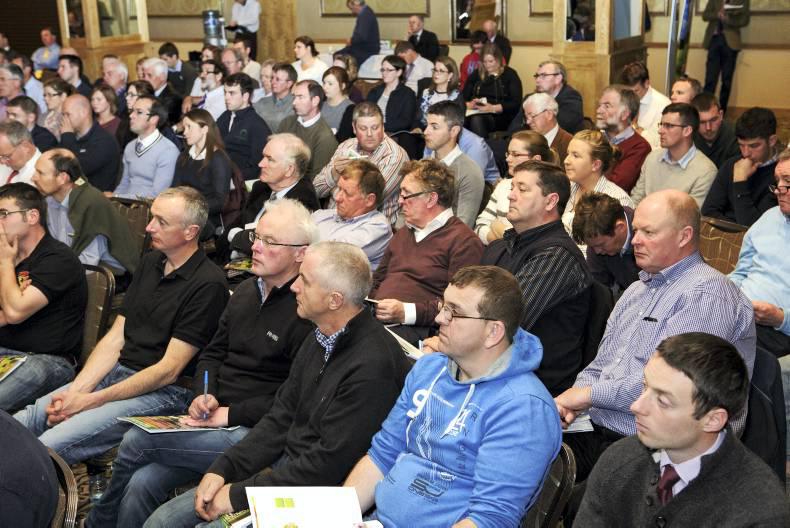“Urea is a viable alternative to CAN for Irish farmers,” according to Dr Patrick Forrestal from Teagasc Johnstown Castle, who was speaking at the Soil Fertility Conference last week.
Forrestal said urea is a cheaper nitrogen source for grassland and reduces loss of the greenhouse gas N2O when compared to CAN. Based on research carried out on the performance of urea and CAN, Forrestal found that urea gives comparable yield performance to CAN in terms of grass growth throughout the year, particularly at lower rates, but had lower total nitrogen (N) recovery. Lower N recovery is a result of ammonia loss which can occur at all times of the year and is related to conditions at the time of application.
Forrestal explained that some farmers are reducing this problem by spreading in damp conditions or just before rain.
“Farmers could consider having urea on hand during the year and spreading it shortly ahead of rain when the opportunity arises, thereby taking advantage of the cost savings,” he said.
He added that very positive results were found with urea stabilised by N-(n-butyl) thiophosphoric triamide (fertiliser granule coated with urease inhibitor) which reduced urea ammonia loses by 78%. Stabilised urea is available commercially for Irish farmers and is selling at approximately €20/t less than CAN per kg of nitrogen.
A worrying statistic revealed at the conference was that 90% of Irish soils are suboptimum in terms of fertility. Pat Murphy, head of environment knowledge transfer at Teagasc Johnstown Castle, said that the poor fertility status of Irish soils is threatening growth targets for the industry. This, he said, was one of the main reasons Teagasc launched the NMP-Online (nutrient management planning). It’s a new fertility mapping service for farmers allowing agricultural advisers to display the fertility status of clients’ farms in a colour-coded map format based on the most recent soil fertility test results. The maps will also give easy-to-read fertiliser recommendations for each field. It is hoped the maps will help farmers make better decisions and plan where to target slurry and chemical fertiliser inputs. The service is due to be operational in November following training courses for users.
“Urea is a viable alternative to CAN for Irish farmers,” according to Dr Patrick Forrestal from Teagasc Johnstown Castle, who was speaking at the Soil Fertility Conference last week.
Forrestal said urea is a cheaper nitrogen source for grassland and reduces loss of the greenhouse gas N2O when compared to CAN. Based on research carried out on the performance of urea and CAN, Forrestal found that urea gives comparable yield performance to CAN in terms of grass growth throughout the year, particularly at lower rates, but had lower total nitrogen (N) recovery. Lower N recovery is a result of ammonia loss which can occur at all times of the year and is related to conditions at the time of application.
Forrestal explained that some farmers are reducing this problem by spreading in damp conditions or just before rain.
“Farmers could consider having urea on hand during the year and spreading it shortly ahead of rain when the opportunity arises, thereby taking advantage of the cost savings,” he said.
He added that very positive results were found with urea stabilised by N-(n-butyl) thiophosphoric triamide (fertiliser granule coated with urease inhibitor) which reduced urea ammonia loses by 78%. Stabilised urea is available commercially for Irish farmers and is selling at approximately €20/t less than CAN per kg of nitrogen.
A worrying statistic revealed at the conference was that 90% of Irish soils are suboptimum in terms of fertility. Pat Murphy, head of environment knowledge transfer at Teagasc Johnstown Castle, said that the poor fertility status of Irish soils is threatening growth targets for the industry. This, he said, was one of the main reasons Teagasc launched the NMP-Online (nutrient management planning). It’s a new fertility mapping service for farmers allowing agricultural advisers to display the fertility status of clients’ farms in a colour-coded map format based on the most recent soil fertility test results. The maps will also give easy-to-read fertiliser recommendations for each field. It is hoped the maps will help farmers make better decisions and plan where to target slurry and chemical fertiliser inputs. The service is due to be operational in November following training courses for users.






 This is a subscriber-only article
This is a subscriber-only article










SHARING OPTIONS: